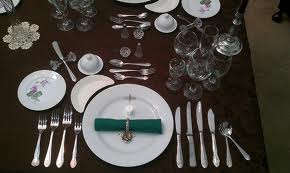Mind Your Manners
A Little Extra
 When dining out–or having guests at home, you might want to know which side the fork goes on, especially when you’re trying to impress someone that you really are civilized! These basic guidelines will help you with any occasion. There are, of course, worse fates in life than not knowing which fork to use. But if you want to be a bit more polished at the table, you’ve come to the right place.
When dining out–or having guests at home, you might want to know which side the fork goes on, especially when you’re trying to impress someone that you really are civilized! These basic guidelines will help you with any occasion. There are, of course, worse fates in life than not knowing which fork to use. But if you want to be a bit more polished at the table, you’ve come to the right place.
It’s the little things you do
that add a special sweetness
to the lives of those around you.
Why Table Manners?
Good table manners and correct etiquette are the rules that are there to make good times better and social occasions go more smoothly. Etiquette is similar to the rules of a game, learning how to play will make everyone a “team.”
Set the example—be at ease. At home or in a restaurant, table manners are the same.
Dining Out
In a fine restaurant you will be greeted by a maître d’ or host. This is who you made reservations with and who will arrange for your seats. The maître d’ is in charge of the floor and outranks everyone else in the dining room. In a large restaurant he may have captains or headwaiters to assist him each in charge of a section of the dinning room. They may take your order in some restaurants.
From Seating to Eating
Have a seat:
Try to sit to your right. Don’t slump, sit up straight. Remember we’re civilized. Don’t place anything on the table. Keys, purses, etc. should be placed on the floor.
The Napkin:
If your waiter, who is your host, doesn’t place the napkin in your lap, your napkin will be to your left if it’s not on your plate. Napkins are our oldest eating utensil, going back before silverware when people ate entirely with their fingers. Placing the napkin in your lap indicates the beginning of the meal. In a home setting, you would wait until your host or hostess places his or her napkin in his or her lap, thus indicating that mealtime has truly arrived. Keep your napkin in your lap to catch falling crumbs or spills and to be out of sight of our dinning companions. Bring it up and blot, not whip your face. DO NOT use it to clean eye-glasses or silverware. You will try not to use it very often. You should also bring a Kleenex with you as your napkin should not be used as a handkerchief.
Utensils:
More than one fork? What will I do? The rule is to start from the outside and work your way in. It is actually quite nice to have a clean fork with each new plate of food. The number of utensils indicates how many courses are planned. You would only put out what was needed if you were setting this up at home.
Once silverware is picked up from the table it never is put back on the tablecloth. Leave it on your plate. We don’t put dirty utensils on the table cloth.
If you use the wrong fork. Don’t worry. Ask your waiter to bring you another. If you drop a utensil just leave it.
Waiter Signals:
There is a rule for placing your silverware on the plate. The inverted V position of the silverware means that I am just resting and am not finished. Placing the utensils on the right side of the plate signals that I am finished. Your host/waiter will serve you from your left but will remove the food and dishes from your right. This makes it easy for him to pick it up using his thumb to secure your silverware. Don’t worry, however, most waiters don’t know this rule.
Do not wave you napkin or raise your hands or whistle to attract the waiters. Wait patiently and use eye contact to get your waiters attention.
Pace Yourself:
Try to keep pace with your dinner companions. Don’t get too far ahead or behind them as the host is trying to serve each course at the same time.
Ordering
Don’t pretend to understand a foreign language menu. Don’t pretend to speak French—ask your waiter what a dish is or for his advice as to what he recommends to eat.
Try to order the same number of courses as your dining companions so that everyone at the table has something to eat at the same time. If you should happen to be the one, however, without a salad or soup etc. you should urge your dining partners to go ahead and eat. The idea is to keep pace and enjoy the meal together. So try not to get too far ahead or behind them as the host is trying to serve each course at the same time.
Wine
You may have a special wine steward. If several of you are going to have the same kind of wine you would, of course, order a bottle. Otherwise, order by the glass. White wine is usually preferred with fish and red wine with most other meats. White wine and champagne glasses are held from the stem to keep it cool. Hold a glass of red wine on the glass itself so that the hand warms up the bouquet of the wine. It is always OK not to drink alcoholic beverages— so don’t feel pressured to drink for some social impressive contest.
Bread
Your bread plate is on your left. You may have a little butter knife or spreader. You should break bread into small pieces with your hands and butter only the portion you are about to eat. This tradition was to insure that you didn’t butter bread you weren’t going to eat.
Place a pat of butter on the side of the bread plate and use it as needed. If you must try something from another’s plate, have them put it on your bread plate. It is unsanitary and unseemly to eat off of anothers plate.
Appetizer
The little fork above your plate is for your appetizer. Don’t overstuff yourself on this for you will have a lot more food coming.
Soup
Scoop away from you so that drips will fall into the dish. Be careful here too, no slurping!
Salad
The rule for silverware is to start outside and work your way in. In Europe, salad may not be served until after the entree.
Entree
It is perfectly alright to talk and enjoy yourself at mealtime, however, don’t talk with your mouth full of food. It is unappetizing to watch someone’s partly eaten food. Smile, swallow, and then talk.
You should take small bites and that way, if you eat something you don’t like, you don’t have a big piece in your mouth. This is also good idea to make conversation easier. It is awkward if you just stuffed your mouth full and have to wait a full minute before you can respond. Digestion is better if you chew your food anyway. If you cannot swallow a bite for some reason, use your napkin and be discreet. If you must cough or sneeze, face away from your company and cover your mouth. If you need to do something more, excuse yourself and go the restroom. Always leave your napkin on the seat and push your seat forward. Do not place your napkin on the table. People don’t like to have to look at your dirty napkin on their table while they are eating.
Most foods will be eaten with a fork and knife—even chicken. Some things such as artichokes are expected to be eaten with fingers.
Dessert
Your waiter will bring you a dessert menu or review all dessert options after he has cleared the table. You may wish to have coffee or hot herb tea.
Only after all food has been finished should you bring your napkin up on the table. No need to re-fold it—just pull it up through your thumb hold and place it to the left of your plate.
Now, especially since you’ve finished the meal, it is perfectly acceptable to put your elbows on the table while talking.
Tips
Your waiters tip is his primary income. You should tip 15% of the total before taxes, 20% for outstanding service is perfectly acceptable. Even if service is less then perfect, you should still leave at least 10% tip —unless it was a nightmare—in which case, you should talk with the management or maître d’.
It is not out of line to send complements to the chief or to even ask for the chef to come to the table if possible. Chefs love to be praised for their food, even though in most big restaurants he or she is a manager and not a cook.
If coats and hats are checks a $1 tip for each is expected.
Valet service should also receive at least a $2 tip.
Remember…
If you forget some rule just remember to be considerate of your tablemates. Kindness toward others and your own common sense will get you through the meal.
Bonappetito.



